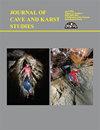斯坦顿堡洞穴和萨克拉门托山脉北部:区域地质和水文背景
IF 0.5
4区 地球科学
Q4 GEOSCIENCES, MULTIDISCIPLINARY
引用次数: 0
摘要
斯坦顿堡洞穴位于新墨西哥州中南部萨克拉门托山脉北部,是在二叠纪中期的圣安德烈斯石灰岩中形成的。这个洞穴位于Mescalero拱门的西侧,这是一个广阔的结构分水岭,将平缓倾斜的东部山坡与西边的图拉罗萨和塞拉布兰卡盆地的低结构地区分开。斯坦顿堡岩洞位于西拉布兰卡盆地高海拔的大量硅质沉积岩露头以及火成岩和火山岩的下坡处。这种复杂的地质环境导致地表排水系统起源于非碳酸盐基岩,因此碳酸钙可能不饱和,这使得下游溶解和洞穴形成的可能性更大。该地区普遍存在增生和溶解作用的证据。与活跃的和废弃的泉水有关的凝灰岩丘是萨克拉门托南部的一个共同特征。斯坦顿堡洞穴最独特的增生特征是雪河地层,这是一个由白色方解石组成的水池沉积物,覆盖在雪河通道的底部,目前延伸超过17公里,其南端仍未确定。从雪河沉积物采集的岩心样品显示出层状的内部结构,表明在通道流被激活的时期,亚毫米尺度方解石层状的幕式沉积。基底层的年龄被确定为只有820年,这表明在过去的一千年里,气候或水化学条件发生了突然变化。雪河通道中水流的起源尚不清楚,但似乎与萨克拉门托山脉北部的极端夏季降水事件或冬季大雪有关。实地观测和水文记录支持了雪河通道的一个或多个水源,这些水源是通过天坑或从洞穴中最西南的地图站点向上倾斜的失去的溪流。本文章由计算机程序翻译,如有差异,请以英文原文为准。
Fort Stanton Cave and the northern Sacramento Mountains: Regional geologic and hydrologic context
Fort Stanton Cave, located in the northern Sacramento Mountains of south-central New Mexico, is formed in the middle Permian San Andres limestone. The cave is situated on the west flank of the Mescalero Arch, a broad structural divide separating the gently dipping eastern slopes of the mountains from structurally low areas of the Tularosa and Sierra Blanca Basins to the west. Fort Stanton Cave is located downgradient from extensive outcrops of siliciclastic sedimentary rocks as well as igneous and volcanic rock exposed at higher elevations in the Sierra Blanca Basin. This complex geologic setting results in surface drainage systems that originate on non-carbonate bedrock and are thus probably undersaturated with respect to calcium carbonate, making downstream dissolution and cave formation more likely. Evidence of both accretionary and dissolutional processes are widespread in the region. Tufa mounds associated with active and relict springs are a common feature in the southern Sacramentos. The most distinctive accretionary feature in Fort Stanton Cave is the Snowy River formation, a pool deposit composed of white calcite that coats the floor of the Snowy River passage, and currently extends >17 km with its southern terminus still undefined. Core samples collected from the Snowy River deposit reveal a laminated internal structure, indicating episodic deposition of sub-millimeter scale calcite laminae during periods when the passage stream is activated. The age of the basal layer has been determined to be only 820 years old, suggesting an abrupt change in climatic or hydrochemical conditions within the past millennium. The origin of water flow in the Snowy River passage is unknown, but appears to be associated with extreme summer precipitation events or heavy winter snowfall in the northern Sacramento Mountains. Field observations and hydrograph records support a point source or sources for water in the Snowy River passage via sinkholes or losing streams upgradient from the southwesternmost mapped stations in the cave.
求助全文
通过发布文献求助,成功后即可免费获取论文全文。
去求助
来源期刊

Journal of Cave and Karst Studies
地学-地球科学综合
CiteScore
1.90
自引率
0.00%
发文量
6
审稿时长
>12 weeks
期刊介绍:
The Journal of Cave and Karst Studies is a multidisciplinary journal devoted to cave and karst research. The Journal is seeking original, unpublished manuscripts concerning the scientific study of caves or other karst features. Authors do not need to be members of the National Speleological Society, but preference is given to manuscripts of importance to North American speleology.
 求助内容:
求助内容: 应助结果提醒方式:
应助结果提醒方式:


